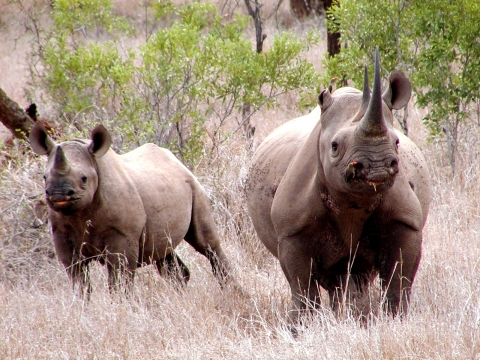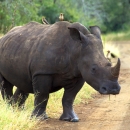Management and Conservation
Rhinos and tigers are big, powerful, and charismatic animals. Unfortunately, these same qualities make these magnificent creatures popular targets: rhinoceros horn and tiger pelts and body parts are in high demand on the global black market.
Five species of rhinos survive in Africa and Asia, but they are all under threat. Africa is home to the black rhino and white rhino, which are classified by the IUCN Red List as critically endangered and near threatened, respectively. Asia is home to the greater one-horned rhino, which is classified as vulnerable, and the Javan and Sumatran rhinos, both of which are classified as critically endangered.
At the beginning of the 20th century, approximately 500,000 rhinos roamed across Africa and Asia. By 1970, the global number dropped to 70,000. Black and white rhinos were hunted to precariously low numbers throughout Africa and were extinct in 15 African countries by the early 1960s and 1970s. Ambitious anti-poaching campaigns and reintroduction programs allowed population increases and reintroduction to sites where they had gone locally extinct. By 2017, there were approximately 5,500 black rhinos and 18,000 white rhinos in Africa.
However, since then, the poaching of rhinos for their horns has once again surged in Africa. Rhino poaching has also shifted from opportunistic poaching by locals to coordinated, targeted poaching and trafficking by international criminal networks.
In Asia, the status of both rhinos and tigers is also bleak. There has been some conservation success with the greater one-horned rhino, which now numbers around 3,700 individuals in South Asia. This small population increase is mainly due to strict protections from Indian and Nepalese wildlife authorities. In addition to the continued threat of poaching, harassment, encroachment, habitat destruction and loss, and conflicts between humans and rhinos still represent major threats to the one-horned rhino.
Sumatran rhinos live in dense tropical forests across parts of Southeast Asia. Today, there are fewer than 100 Sumatran rhinos left in the wild. Although their survival continues to be under threat from poaching and habitat loss, the decline in their population has slowed down, thanks to the efforts of dedicated anti-poaching teams known as Rhino Protection Units.
With approximately 75 individuals left, the Javan rhino is believed to be the rarest large mammal on earth. Today, the Javan rhino is confined to a single population in Indonesia's Ujung Kulon National Park. The greatest threat to its survival is its small population size, and the inbreeding and loss of genetic diversity that this will bring about. In addition, the Javan rhino is threatened by poaching and habitat destruction and loss, primarily for agriculture and development.
Once abundant throughout Asia, tigers now live in small, fragmented groups. Approximately 97 percent of wild tigers were lost during the last century, and experts estimate there are now fewer than 4,000 tigers in the wild. The known tiger range has declined by 93 percent, and tigers are now estimated to inhabit less than 7 percent of their historic range. All six subspecies of tiger – Sumatran, Amur, Bengal, Indochinese, South China (extinct in the wild), and Malayan tiger - are considered endangered or critically endangered according to the IUCN Red List. In addition to the threat of illegal wildlife trafficking to meet demand for tiger skins, tiger bone wine, and other tiger-derived products, tigers are severely threatened by habitat loss and retaliatory killings due to human-wildlife conflict.
Our Services
Our Projects and Research
Examples of successful current and past projects include:
Indonesia: In addition to existing land-based patrols, marine patrols were established to protect the coastline of Ujung Kulon National Park, home of the Javan rhino, from poachers and encroachers. In 2021 these marine patrols covered more than 13,900 kilometers, encountered 235 instances of illegal activities, and documented evidence that was provided to the park authorities.
Kenya: Through a five-year project, conservation efforts in Ol Jogi Conservancy, Borana Conservancy, Lewa Wildlife Conservancy, and on the Association of Private and Community Land Rhino Sanctuaries are being strengthened for the protection and biological monitoring of Eastern black rhinoceros. Activities address rhinoceros poaching, the need for biological management for rhinoceros, and the new threats to the Conservancies’ income generation due to the loss of revenue from tourism and other global economic factors because of COVID-19.
Namibia: Five-years of operational support to the Government of Namibia, key non-governmental organizations, and the rhino custodian program are helping to protect the Southwestern subspecies of critically endangered black rhinos and their habitat against the ongoing poaching crisis.
Nepal: By supporting the government of Nepal’s efforts to monitor the population of tigers, the project helped generate crucial data required to evaluate the conservation efforts in the country. The results confirmed an increase in tiger numbers over a five-year period.
Thailand: Continued funding over multiple years for patrolling based on Spatial Monitoring and Reporting Tool (SMART), which has been implemented in important tiger bearing protected areas, has resulted in more consistent and better protection for wildlife and habitat. This is now showing an increasing trend in tiger numbers, and tigers are now also dispersing to other sites.
Zambia: Support in North Luangwa National Park is providing necessary equipment and resources over five years to monitor and protect Southern Central black rhinoceros and their habitat by addressing the impacts of poaching for the illegal trade in rhino horn.

